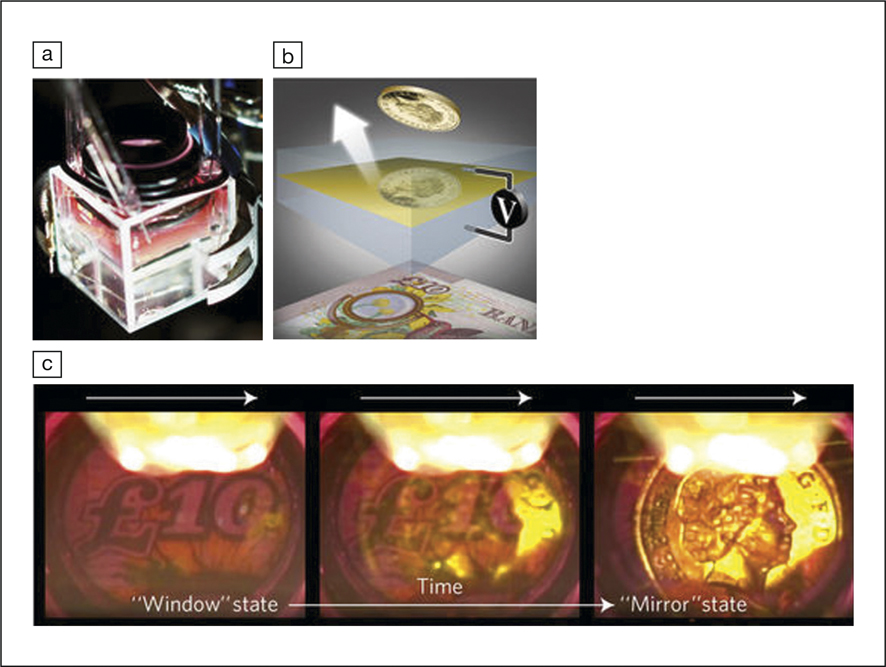A research collaboration between Professors Joshua Edel, Andrew Kucernak, and Alexei Kornyshev of Imperial College London have created a highly-tunable, reversible plasmonic liquid mirror that operates by driving gold nanoparticles to the interface between two liquids in an electrochemical cell. Their results, published recently in Nature Materials (doi:10.1038/NMAT4969), show that these mirrors could be used as switchable windows, variable filters, or aggregators for spectroscopy of dilute materials.
The manipulation of nanoparticles at a liquid interface has been investigated for many years. Given the choice between an organic and an aqueous layer, nanoparticles covered with negatively charged ligands much prefer the low permittivity of the aqueous solution. By increasing the ion concentration in the aqueous layer or applying a voltage, the nanoparticles can be pushed to the interface between the two liquids. In the latter case, reversing the sign of the voltage disperses the nanoparticles again into the aqueous layer. The plasmonic nanoparticle array created by researchers in multiple groups at Imperial College London stands out for its reversibility, tunability, and visible mirror reflectance.
This system was initially proposed several years ago (see Journal of Physical Chemistry C, doi:10.1021/jp9083234), but “it took a number of years to generate these results,” Edel says. One particularly challenging aspect was figuring out how to balance the charged ligands at the surface of the plasmonic nanoparticles. Too little ligand coverage and the van der Waals interactions between the nanoparticles would cause them to stick to each other. On the other hand, a “nanoparticle with too much negative charge won’t assemble at the interface and it most certainly won’t disassemble,” Edel says.
To get to the interface, the nanoparticles diffuse through the aqueous layer in the electrochemical cell. In their experiments conducted in a cell with centimeter-sized dimensions at nanomolar nanoparticle concentrations, it took hours for the particles to form the mirror. A nanofluidic cell, with nanometer dimensions, could be used to minimize the volume the nanoparticles must diffuse through. “Even though it’s limited by Brownian diffusion,” Edel says, “miniaturizing the cell will give us very rapid switching.”

(a) Experimental setup for generating a liquid window–mirror. (b) Schematic showing the set-up with a coin facing the liquid mirror and a currency note at the back of the mirror. (c) Real images observed during the transition between a transmissive “window” state (when no nanoparticles are at the interface) to a reflective “mirror” state (when nanoparticles assemble densely at the interface). Credit: Nature Materials.
This work “establishes the foundations for electrically tunable devices based on nanoparticles at liquid–liquid interfaces,” according to Mark Schlossman of the University of Illinois at Chicago. Schlossman, who is not affiliated with the Nature Materials publication, and the authors of this study mentioned many future applications for this work. From a fundamental perspective, analyzing precisely how the plasmonic particles arrange themselves at the interface with a diffraction experiment could further inform the theoretical calculations used to predict the optical properties of the two-dimensional nanoarray. This technique could also be generalized to different types of nanoparticles or even arrays of more than one nanoparticle. With rapid switching, this type of mechanism could be employed to create windows with controllable reflectance. Kornyshev is interested in investigating nanoparticle assembly at liquid–solid interfaces, which could also be a critical step for using this mechanism in switchable windows.
“It was very much an iterative process between all of us,” Edel says. Kucernak’s group designed an electrochemical cell with negatively charged walls to prevent the nanoparticles from adsorbing to the cell during cycling. Kornyshev’s group modeled the potential driving the nanoparticles to assemble at the interface and devised a theory to predict the frequency of light reflected from the assembled nanoarray. Edel’s group optically measured the properties of the assembled nanoarray. The three groups worked together to determine where to take the project.
Because of Edel’s spectroscopy background, using these arrays for sensing minute concentrations of molecules in liquid environments interests him. According to Edel, “If the nanoparticles assemble at the interface and the target analyte also binds to the nanoparticle, this [controllable nanoarray] generates a pre-concentration mechanism.” The electric field of the plasmonic array enhances the Raman signal from the target molecule by several orders of magnitude, making it sensitive to single molecules.

